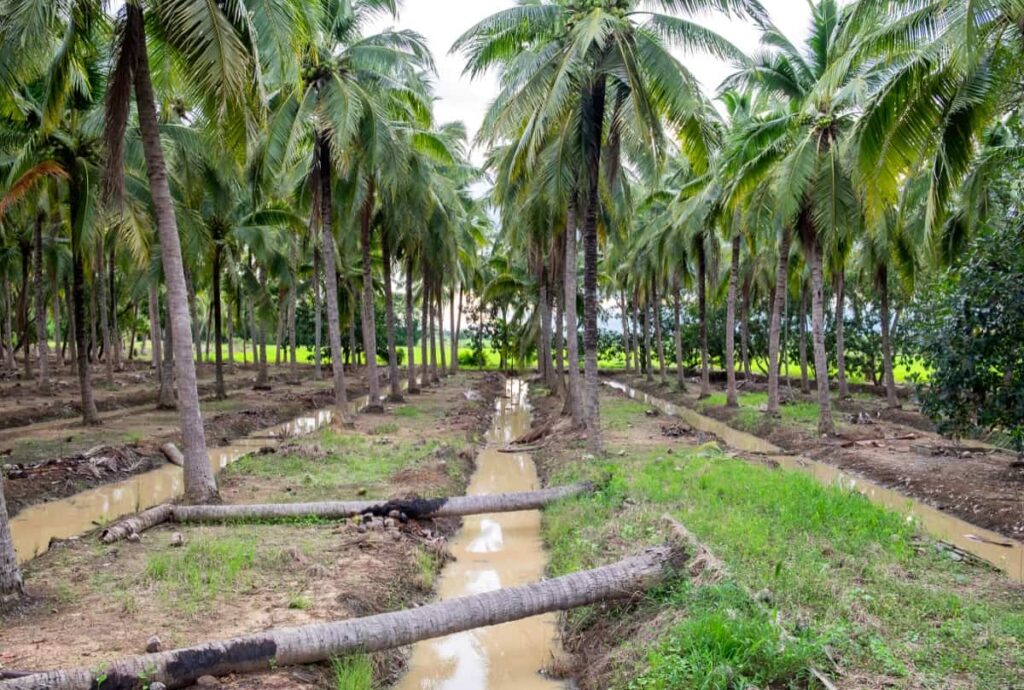- Dieses Thema ist leer.
-
AutorBeiträge
-
-
Januar 21, 2025 um 11:19 pm Uhr #543523
 Agric4ProfitsAdministrator
Agric4ProfitsAdministrator
Coconut farming is a rewarding venture that requires a blend of knowledge, effort, and dedication. Proper management practices are crucial to ensure optimal yield and the long-term sustainability of the farm.
Understanding how to manage a coconut farm effectively can significantly impact its productivity and profitability.
1. Selecting The Right Location And Soil
The location and soil type play a crucial role in coconut farming. Coconuts thrive in tropical regions with sandy or loamy soils that have good drainage. Ensuring the soil has a pH range of 5.2 to 8.0 is ideal for growth.
Regular soil testing and amending it with organic matter or fertilizers help create a conducive environment for healthy coconut trees. This foundational step is vital when learning how to manage a coconut farm.
2. Proper Planting Techniques
Planting coconut seedlings correctly is essential for their development. Saplings should be spaced adequately, typically 25 to 30 feet apart, to allow their roots to grow freely. Planting during the rainy season helps the seedlings establish themselves faster.
When focusing on how to manage a coconut farm, paying attention to planting depth and alignment can prevent early-stage issues.
3. Irrigation And Water Management
Water is a key component of coconut farming, especially in areas with limited rainfall. While coconut trees are drought-tolerant, consistent irrigation enhances yield. Drip irrigation is an efficient method to deliver water directly to the roots, conserving water and promoting growth.
Understanding how to manage a coconut farm includes ensuring the right balance—avoiding overwatering, which can lead to root rot.
4. Pest And Disease Control
Pests like rhinoceros beetles and red palm weevils, along with diseases such as bud rot and leaf spot, can harm coconut trees.
Implementing integrated pest management practices, such as using organic insecticides and maintaining farm hygiene, can reduce infestations. Regular monitoring and timely action are crucial steps when learning how to manage a coconut farm to protect trees from potential threats.
5. Fertilization And Nutrient Management
Fertilizing coconut trees properly ensures robust growth and higher yields. Nutrients like nitrogen, potassium, and phosphorus are essential for the trees’ health.
Organic options such as cow dung, compost, or green manure improve soil fertility sustainably. A comprehensive nutrient management plan is a key aspect of how to manage a coconut farm effectively.
Learning how to manage a coconut farm requires attention to detail, consistency, and a proactive approach. By selecting suitable soil, ensuring proper irrigation, controlling pests, and maintaining a nutrient-rich environment, farmers can achieve high yields and sustainable growth.
A well-managed coconut farm not only boosts productivity but also contributes to the livelihood and economic prosperity of its caretakers.
Read Also: Coconut Processing Plant Cost: An Investment In Value Addition
-
-
AutorBeiträge
- Du musst angemeldet sein, um auf dieses Thema antworten zu können.






